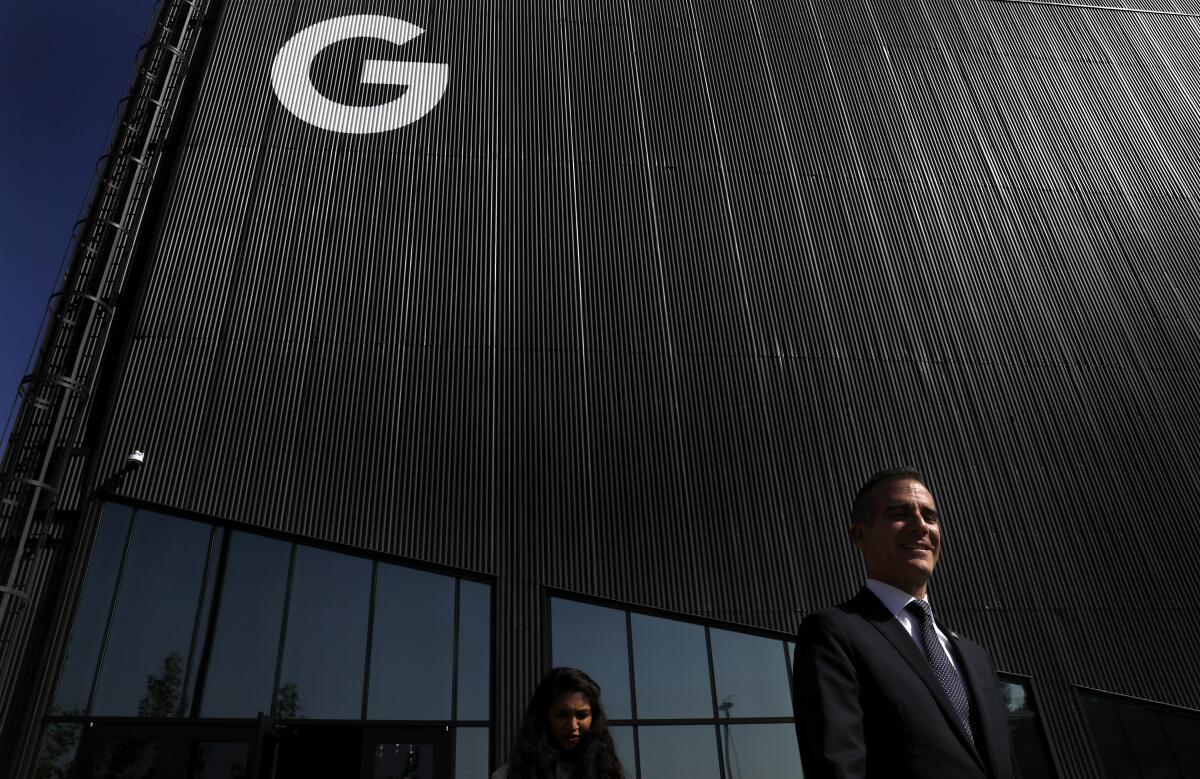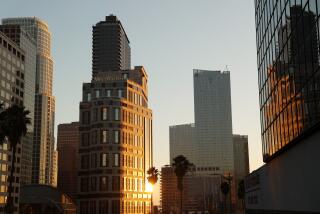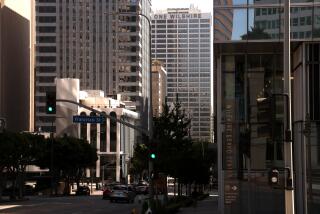Google, Amazon, Netflix and their tech pals storm L.A.’s office market

Technology companies have been hiring at such a rapid pace that they have come to rule the Los Angeles office market and are spreading their influence into neighborhoods such as Silver Lake and West Adams that were not previously considered white-collar business centers.
The Los Angeles area now has the third-largest tech workforce on the West Coast, behind San Francisco and Seattle, yet still doesn’t have nearly enough jobs for all the graduates coming out of local colleges, according to a recent report by real estate brokerage CBRE.
“We have been a net exporter of tech talent these past years, but that is changing as L.A. continues to attract major companies planning to expand,” broker Jeff Pion said.
Most of the expansion has come from tech companies focused on media and entertainment such as Netflix, Amazon and Google. Although they are based elsewhere, these companies and other big tech employers are expanding in Southern California in large part because it is the home of the entertainment business.
Office landlords are benefiting mightily from the growth. The Los Angeles office market has been on the upswing since 2013 and showed no sign of stalling in the second quarter as tech and entertainment firms continue to expand into new space.
Developers are responding to the demand by building new offices that are often rented long before they are completed, which was unusual during previous real estate cycles when tenants typically waited to see finished buildings before making commitments.
About 3.8 million square feet of office space is under construction in L.A. County and 50% of that is pre-leased, said Petra Durnin, CBRE’s director of research for the region.
“We have never seen that before in Los Angeles,” Durnin said. “That’s the highest percentage ever.”
Tech-related tenants are now the “bedrock” of the Los Angeles office market, Durnin said, surpassing the legal and financial services firms that previously dominated office leasing.
Also new is where the creative companies are setting up shop as they spread into nontraditional office markets that can be cheaper and hipper than long-dominant business centers such as Century City and downtown L.A.’s financial district.
Koreatown, Long Beach, Silver Lake and Echo Park, neighborhoods that are attractive to a lot of millennials as places to live and play, are among the places creative tech companies are landing, Durnin said.
“Across L.A., tech has infiltrated every single submarket now,” she said. “It’s really changing how we look at office markets.”
Some creative tenants are searching for more affordable space than can be found in hot tech markets such as Santa Monica, Playa Vista and Culver City.
West Adams, a historic neighborhood southwest of downtown dating to the late 19th century, is growing in appeal, real estate brokerage Newmark Knight Frank said in a recent report.
West Adams is in a federal Opportunity Zone, which offers tax incentives to investors, and is close to the future Crenshaw Metro Line expansion that will link the Expo Line to the Green Line and provide service to downtown, Santa Monica and Los Angeles International Airport.
Fast casual restaurant chain Sweetgreen Inc. recently agreed to move its headquarters from trendy Culver City to a 50,000-square-foot former industrial building in West Adams, and other office conversions are on the way in the neighborhood that are expected to appeal to tech types.
Typically, tech offices are on the small side. Although such well-known juggernauts as Netflix, Amazon and Google have each signed leases for hundreds of thousands of square feet in recent years, the average tech tenant occupies about 13,000 square feet, according to CBRE.
“Their general preference is for more historical, cool-type buildings” that are typically only a few stories tall but have large floors for an open-space environment,” said Colin Yasukochi, CBRE’s head of research for Northern California.
“They also want a vibrant environment outside,” he said. “Their facilities are recruiting tools to attract and retain talent.”
The companies have plenty of fresh talent at hand to choose from. Los Angeles-area schools such as USC, UCLA, Caltech and UC Irvine have produced about 42,000 graduates in fields such as computer hardware and software engineering in the last five years while about 20,000 tech jobs were created in the region.
Nationally, the supply of tech talent is still short and has damped momentum of company expansion in many leading tech markets, CBRE said. The tech workforce grew by 16% in the last five years, compared with an average of 9% for all U.S. professions.
“That type of growth can deplete even the deepest pools of qualified labor,” Yasukochi said.
Partly as a result, smaller markets including Tucson and Las Vegas have snapped up tech grads for start-ups, small-scale companies and tech jobs with nontech employers such as banks and services firms.
Tech workers in Los Angeles earn an average of $104,000 a year, a 12% increase over the last five years and 8% above the national average, CBRE said.
The second-highest cost after employee wages for most companies is office rent. Los Angeles ranked as the third most expensive office market surveyed by CBRE (after New York and the San Francisco Bay Area) and fourth in terms of apartment rents (after New York, the Bay Area and Long Island).
Landlords in Los Angeles County asked for an average of $3.70 per square foot per month for Class A space in the second quarter, unchanged from the same period a year earlier, the brokerage said. Less traditional space favored by tech companies can run even higher, hitting $5.62 in Marina del Rey.
Overall vacancy also held steady at 14.3%, even as thousands of square feet of new offices hit the market.
The robust absorption of new and vacant office space should continue, Durnin said, as big tech companies stake out their territories and plan for expansion in the years ahead.
“There are two things going on,” she said. “One is a space grab to hedge against future growth, and the other is to keep your competitors out of space you want to be in.”
More to Read
Inside the business of entertainment
The Wide Shot brings you news, analysis and insights on everything from streaming wars to production — and what it all means for the future.
You may occasionally receive promotional content from the Los Angeles Times.











